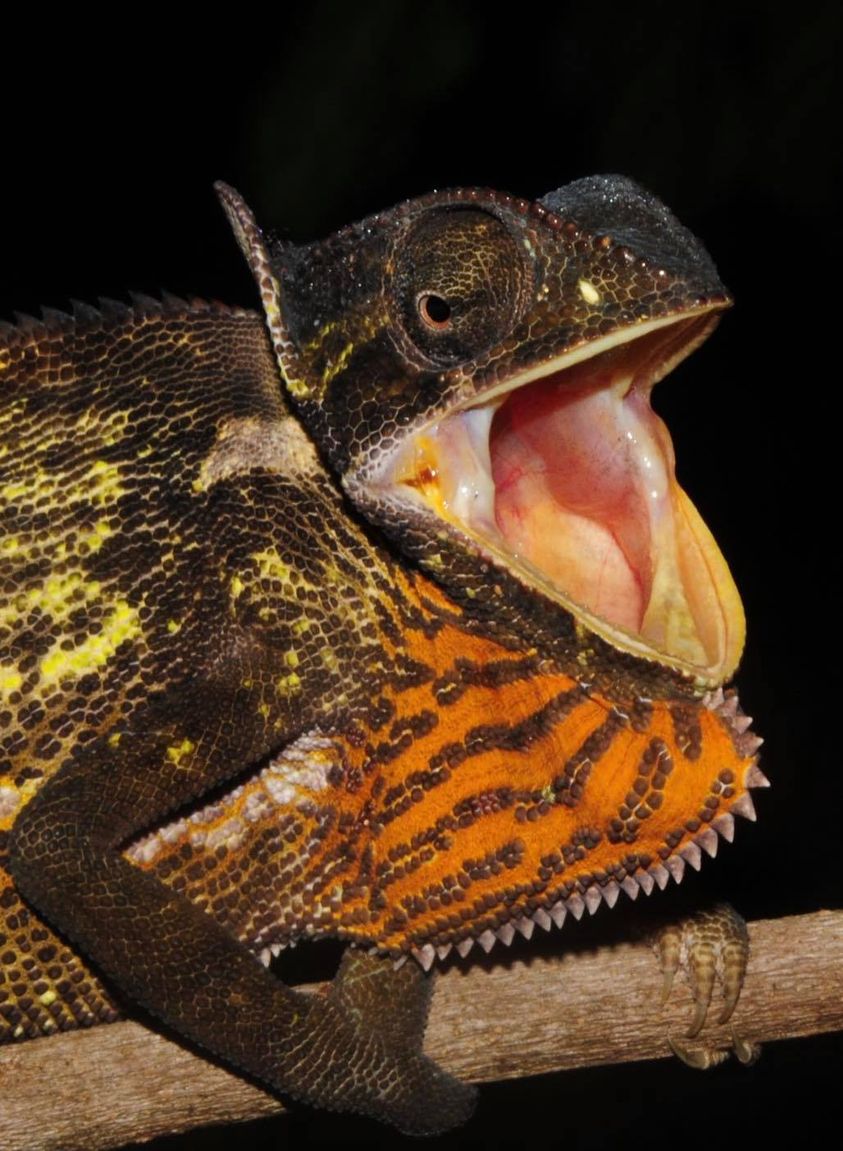Egg Binding, Dystocia
The oviparous chameleon species lay their eggs at the end of several weeks of gravidity different ways. We have still very dew data and observations about egglaying aspects from the wild. There are few types of species concerning the way how they lay the eggs:
Deep diggers (e.g. Furcifer verrucosus, F. labordi, C. gracilis): species from dry biotopes must dig deep (20-40cm to ensure the eggs are laid in a favorably moist environment to survive and develop)Shallow diggers (vast majority of speciesmincluding the most commonly kept ones).
Droppers (small species usually just drop the eggs on forest floor and eventually cover them under a leaf or little debris).
Specialists (Archaius tigris) lays the eggs loosely between the leaf and the stem of palms.
On order to design all necessary conditions in captivity properly, we need to familiarize ourselves with the known data from the wild in case of every species. Experience of breeders made only in captivity might be valid but is often heavily misleading.
GOLDEN RULE: PREVENT AND/OR ACT IN TIME
Keep the female in line with naturalistic chameleonoculture healthy, well nourished and safe; observe the female with increased focus towards the end of gravidity; in case of problems, go to VET in time.
SYMPTOMS:
1. APPEARANCE:
Female full of eggs: eggs visible or palpable in the belly close to cloaca.
Gravid colors: with possible discoloration (light, whitish tones) in the belly area close to cloacaEyes sunken: due tomstress and possible dehydration.
Weakness: the more time is progressing the weaker and slower they are, the grip is a good indicator, as is sleepiness.
2. BEHAVIOR:
Digging a tunnel or more for more than 2 days.
Dropping the eggs from branch or while crawling around on bottom or branches.
Crawling through the cage atypically and/or nervouslyRestlessness.
Staying on the ground.
Refusal to eat and/or drink.
Sleepiness at daytime.
Weakness.
Exhaustion.
Not sleeping at night.
Discoloration(s).
3. CLINICAL PICTURE:
Low level od oxytocine in blood.
Hypoglycaemia (low level of sugar in blood).
Muscular weakness.
Dehydration.
REASONS:
1. WRONG NUTRITION
Mistakes in food spectrum. Too little food - not enough energy, too much food - risk of constipation, blockage of oviducts with eggs by gut content.
Too big feeders - constipation, blockage, autointoxication by decaying gut contentWrong supplementation - too little calcium leads to decalcification of bones, not saturated demand in vitamins and minerals to collapse of homeostasis and/or low egg quality and female weakness, often demonstrated by gular edema.
Too much food and obesity combined with high temperatures leads often to huge amounts of eggs, blocking inner organs, exhausting the female and increasing the demand in nutrients
2. WRONG HYDRATION
Too little water - dehydration, thickening of body fluids, collapse of homeostasis and general weakness.
Too much water - hyperhydration, too much dissolved body fluids, collapse of homeostasis, edematic swellings, immobility. Wrong unnatural way of hydration - absence of humid nights or too much air humidity at daytime leads to collapse of homeostasis and to increased susceptibility to infections, absence of fog is compensated by heavy drinking, causing osmotic shock in intestines, micro-ruptures of intestine wall, digestion problems, intestine inflammations and infections, autointoxication.
3. WRONG ECOSYSTE
Mimproper inner design of the cage, wrong temperatures and humidities during day and night.
4. WRONG LAYING SITE
Absence of laybin (stress, inability to lay eggs)Wrong design of laybin (wrong color, transparent, too small or too large...).
Too deep substrate (exhaustion by too much digging)Too dry substrate (the tunnel collapses, female will refuse to lay eggs).
Too wet substrate (femalemay refuse to lay eggs)Too loose substrate (the tunnel will collapse).
Too low substrate temperature (female may refuse to lay eggs)Too high substrate temperature (female may want to dig deeper).
Wrong placement of the laybin (no privacy, too much light, wrong color of environment, disturbance bz cats, dogs, birds, children, breeder, traffic...).
5. ANATOMICAL DISORDER
Stenosis of the oviducts.
Knits or onstructions ofmoviducts as result of precious infections, injuries, surgeries.
Crossing or blocking of oviducts.
Anomalies of inner organs blocking oviducts.
6. PHYSIOLOGICAL DISORDERS
Inability to produce enough oxytocine.
Wrong calcium and potassium metabolism.
Disballance in calcium intake can cause decalcification of bones in the favor of calcification of eggs, a gravidity- based MBD can quickly develop.
7. SMALL SIZE
Small females produce standard sized eggs, which might be too big to pass through the pelvis and cloaca.
8. OBESITY
The fatbody filling substantial part of the body cavity can block the eggs in the oviducts either itself or while pressing other organs in unnatural positions.
Obesity destroys homeostasis, so weakness, organ failures, inner intoxications can be the resultObesity causes collapse of various inner organs.
8. PATHOLOGY, DISEASE
Injuries (healed or fresh) and scars can block the eggs.
MBD Tumors.
Infections.
Inner organs failures.
10. STRESS
Stress from any above plus e.g. presence of birds, cats, dogs, children, breeder etc. can have a negative influence on the well ring of the gravid female.
Cohabiting is an absolute NO for a gravid female, especially with males.
PREVENTION:
Naturalistic chameleonoculture with focus on simulating all vital factors, great nutrition, health and welfare.
TREATMENT:
If egg binding is suspected, consult onlineFix all above failures if possibleIf the animal dies, try to save the eggs just after its deathSelf-medication impossible, egg binding is a call for VET.
VET will:
1. Inspect the animal.
2. Do X-ray or infrasound investigation.
3. Decide about the use of oxytocine (calcium, glucose etc.)4. Decide about surgery.
DO NOTs:
Never palpate the body with force.
Do not try to massage the eggs out, you can cause a rupture of inner organs incl. oviduct.
Do not wait too long with calling for advice.
Do not wait too long to go to VET.
DISCLAIMER: Animals are not machines, there is a big inconsistency of how they react on such unpleasant situation, so symptoms are subject of big variability. The egg bound state can be total or partial: even after laying a clutch, they still can be eggs remaining in the oviducts.
